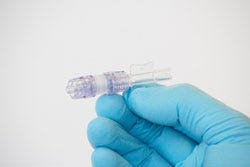Medtech Startup Showdown 2016: Round 1—LineGard Med vs Output Medical
March 28, 2016
| vs. | ||
|
|
|
|
Describe your device and how it will benefit healthcare. | Clinical studies show that 7% of all I.V. lines are dislodged. In the United States alone, there are over 200 million I.V. lines placed annually. I.V. Dislodgment is estimated to cost the U.S. healthcare system nearly $1 billion a year. We are developing a new device to prevent catheter dislodgment called the SafeBreak IV. The current standard for preventing IV dislodgment is the use of tape or more expensive securement devices. While adhesives and securement are important, nothing can prevent dislodgment when a large force is applied to an IV line. The SafeBreak IV fits in-between the patient's catheter and the IV tubing, and creates a sealed liquid connection. Its design allows moderate pull force but separates before the adhesive fails, keeping harmful trauma from being delivered to the patient's IV site. When the device separates, its patented technology prevents blood loss and triggers the IV pump's high pressure alarm to alert the nurse. Replacing a SafeBreak IV is painless and takes seconds, so the patient can quickly resume their medication therapy without having to experience the pain of a dislodged IV and the reinsertion of a new one. The nursing staff can spend their time working on value-added activities and the hospital saves money on supplies, labor, and patient satisfaction. |
| The medical device is an add-on adapter that fits between the Foley catheter and the distal tubing to measure urine output in 20-minute intervals as the urine passes through. We integrate the output data into ICU telemonitor screens and hospital EMRs. As a result, we improve clinical quality, create hospital cost savings, and improve nursing productivity. Our product addresses the limitations that exist in current medical technology using urine output specifically to diagnose acute kidney injury (AKI), a complication that affects nearly 20% of all ICU patients. Urine output is the most important vital sign used in treating patients with AKI. In-hospital acquired AKI is a major cause of increased morbidity and mortality among critical care patients. Several clinical studies suggest a direct correlation between the mortality of AKI and the number and duration of low urine output episodes. These studies show that patients who develop in-hospital AKI are at more than three times higher risk of death. Traditional methods of measuring urine output are inadequate for detecting AKI appropriately. Currently, urine output in ICU patients is measured in hourly intervals--often in intervals of 4 hours-- through a transparent, pliable plastic bag. Studies have shown that this method is inaccurate, with one study finding that current methods only detect 77% of low urine output episodes. Worse still, ICU nurses spend 5%-7% of their time measuring and recording urine output, and these time-intensive tasks result in higher error rates. Further, failing to detect the complications of AKI leads to additional costs of as much as $15,000 per patient, which are absorbed by the hospital in most cases. |
How does your product differ from the competition? | Adhesives, tapes, and expensive securement devices have long been viewed as the last lines of defense in avoiding IV complications. While basic securement is essential, all securement devices will fail eventually, resulting in catheter dislodgment. Unlike basic securement devices, the SafeBreak IV creates a necessary separation in the IV line, allowing us to protect the IV catheter during extreme tension. The SafeBreak IV helps understaffed nurses avoid stressful and time consuming IV dislodgment, and keeps patients progressing through the continuum of care. |
| We are the only device to take into account the clinical use of the device, the dynamic characteristics of urine as a liquid, and the cost structure enabling a price that procurement officers would find amenable for purchasing. We performed survey analysis and use case studies to evaluate how nurses and physicians would use the device. We subsequently developed the timed intervals of data read outs as a result of these studies. The decision to include an add-on adapter close to the site of urine output allows us to be more accurate with the readings as well. Urine is a dynamic liquid that can produce insoluble blood clots and can create sedimentation due to the sodium and potassium salts in the fluid. Other technologies risk clotting because they cannot account for these fluid dynamics. Lastly, the cost structure of the technology allows us to enter the market at a price point that procurement officers would accept. We constructed a Markov-based pricing model to identify the pricing spectrum per patient type that would use this device. The model included incidence and additional cost of complications. In creating a value-add based pricing model, we are able to justify to procurement officers our price. Other technologies have priced their product too high. |
Do you have customers yet? | The device is not yet cleared for sale by FDA, but we will start our first clinical trial in the fall of 2016. |
| We will pilot this device at the University of Chicago Medical Center in late 2016. |
How much money have you raised? | Approximately $900K |
| We raised under $1 million in equity financing. |
Who are your investors? | Zero To 510 Medical Device Accelerator, venture capital firms, and angel investors |
| Physicians, Medical Device Executives, and Mariam Global Health |
What is the next milestone for your device? | FDA 510(k) clearance is the next milestone for our device. We will be submitting our 510(k) in the fall of 2016. |
| We will submit the FDA application once the alpha build is complete. We will then initiate a clinical study at the University of Chicago Medical Center. |
You May Also Like





.png?width=300&auto=webp&quality=80&disable=upscale)
